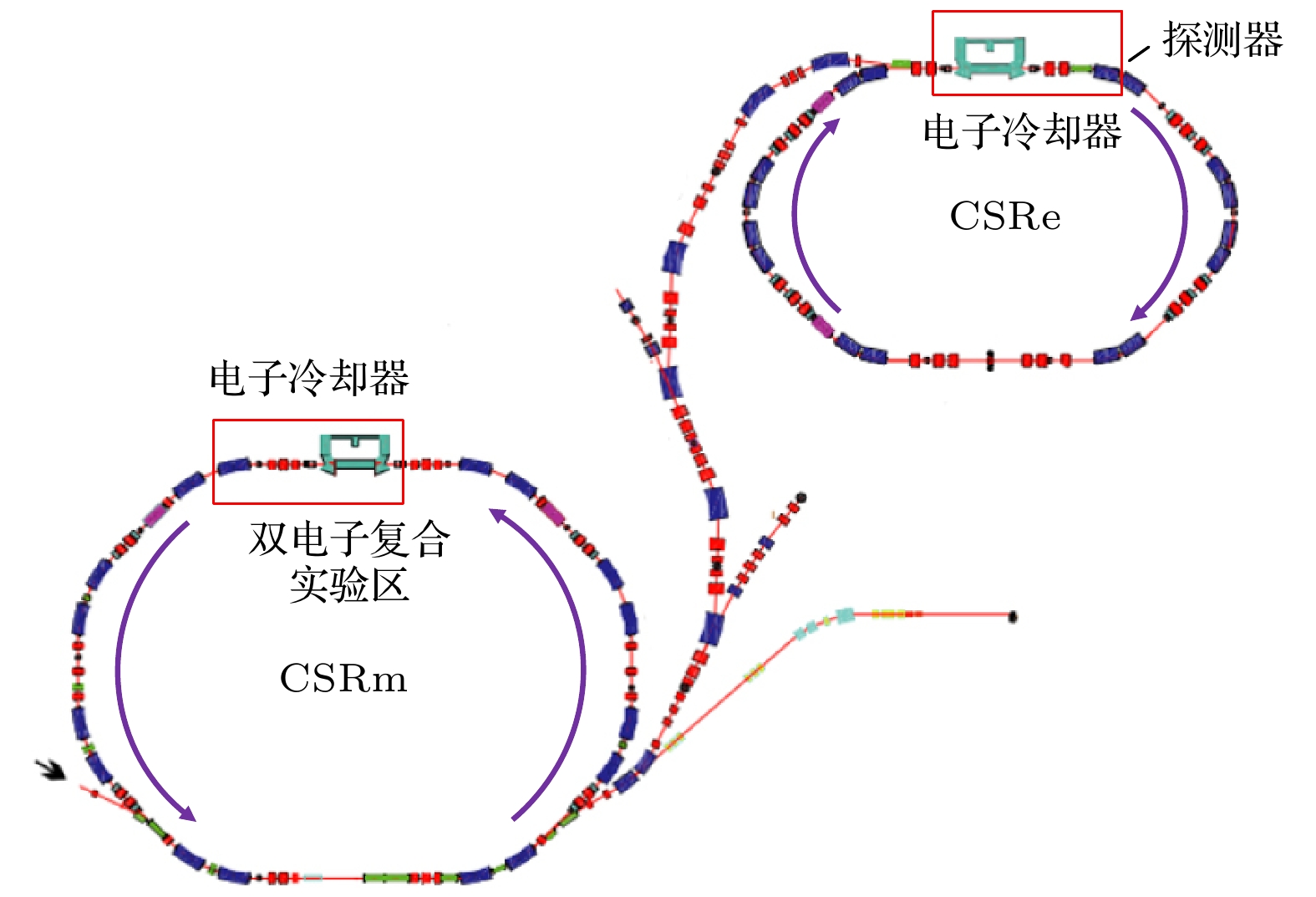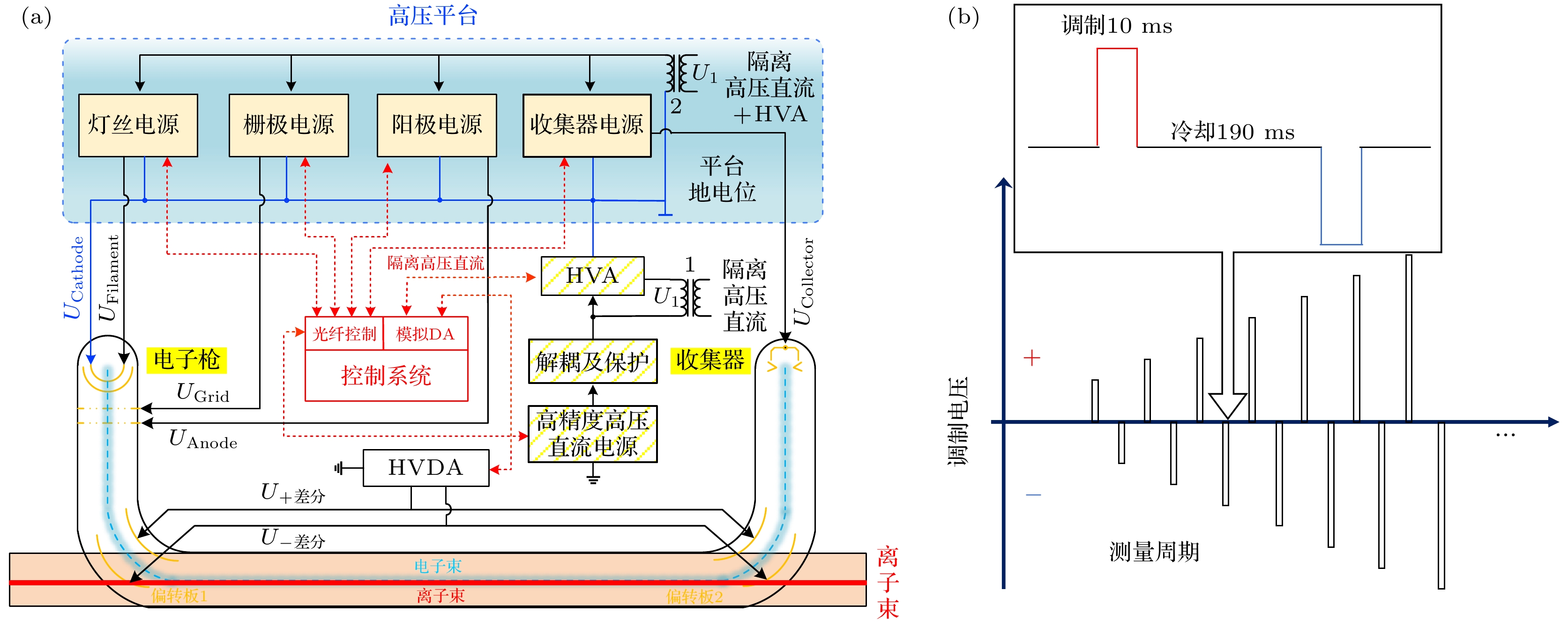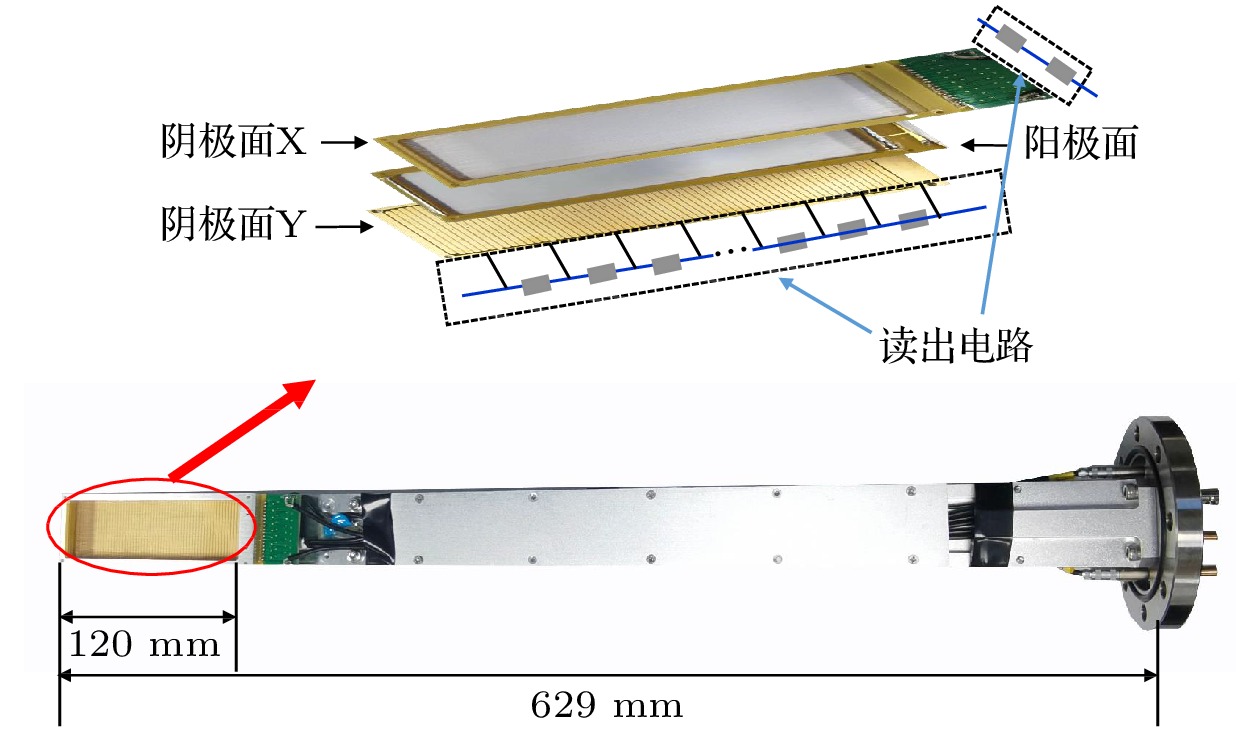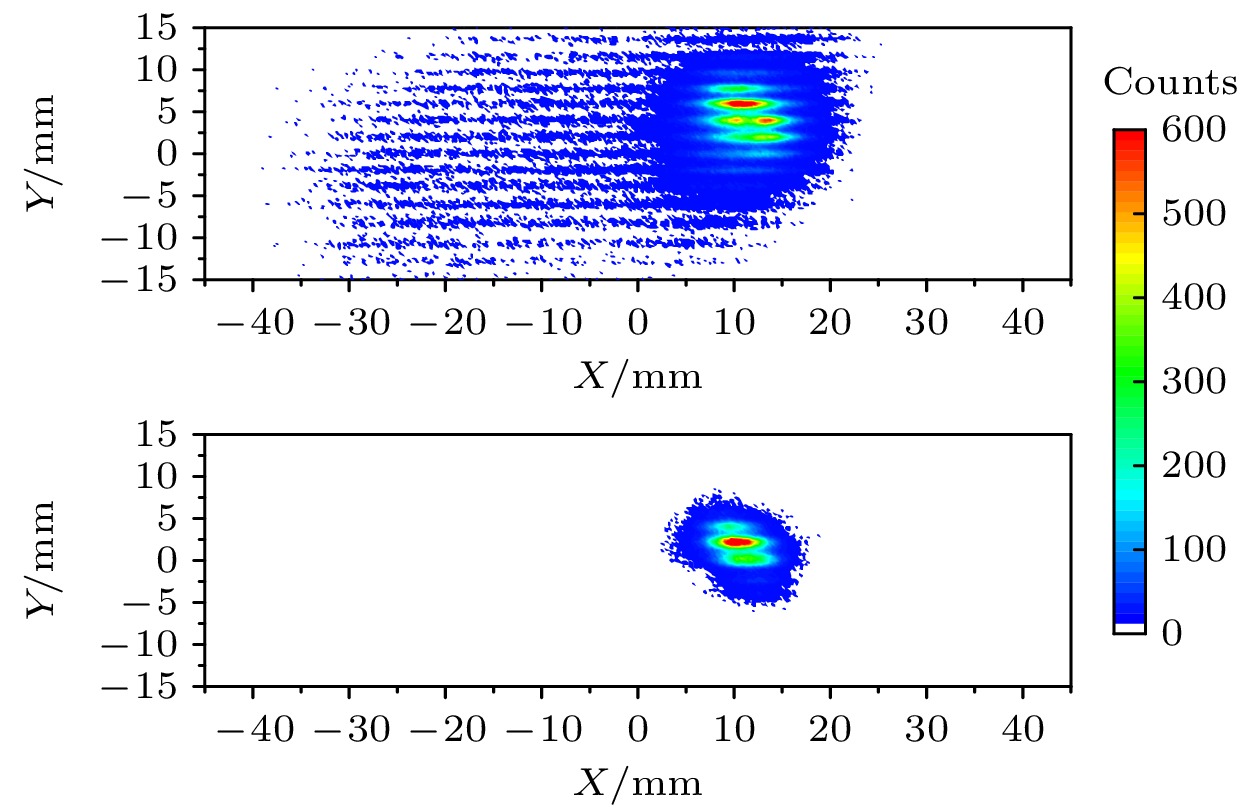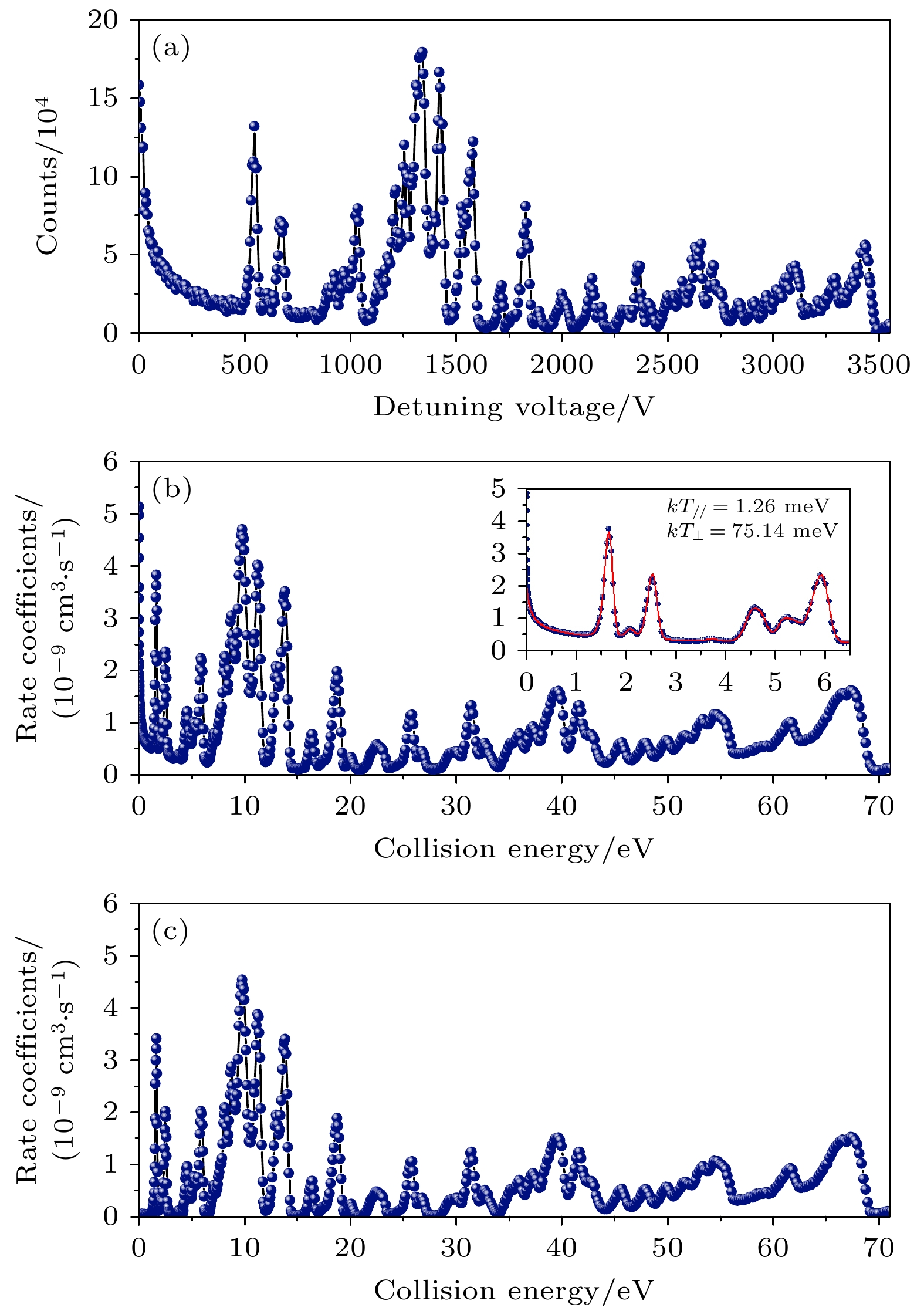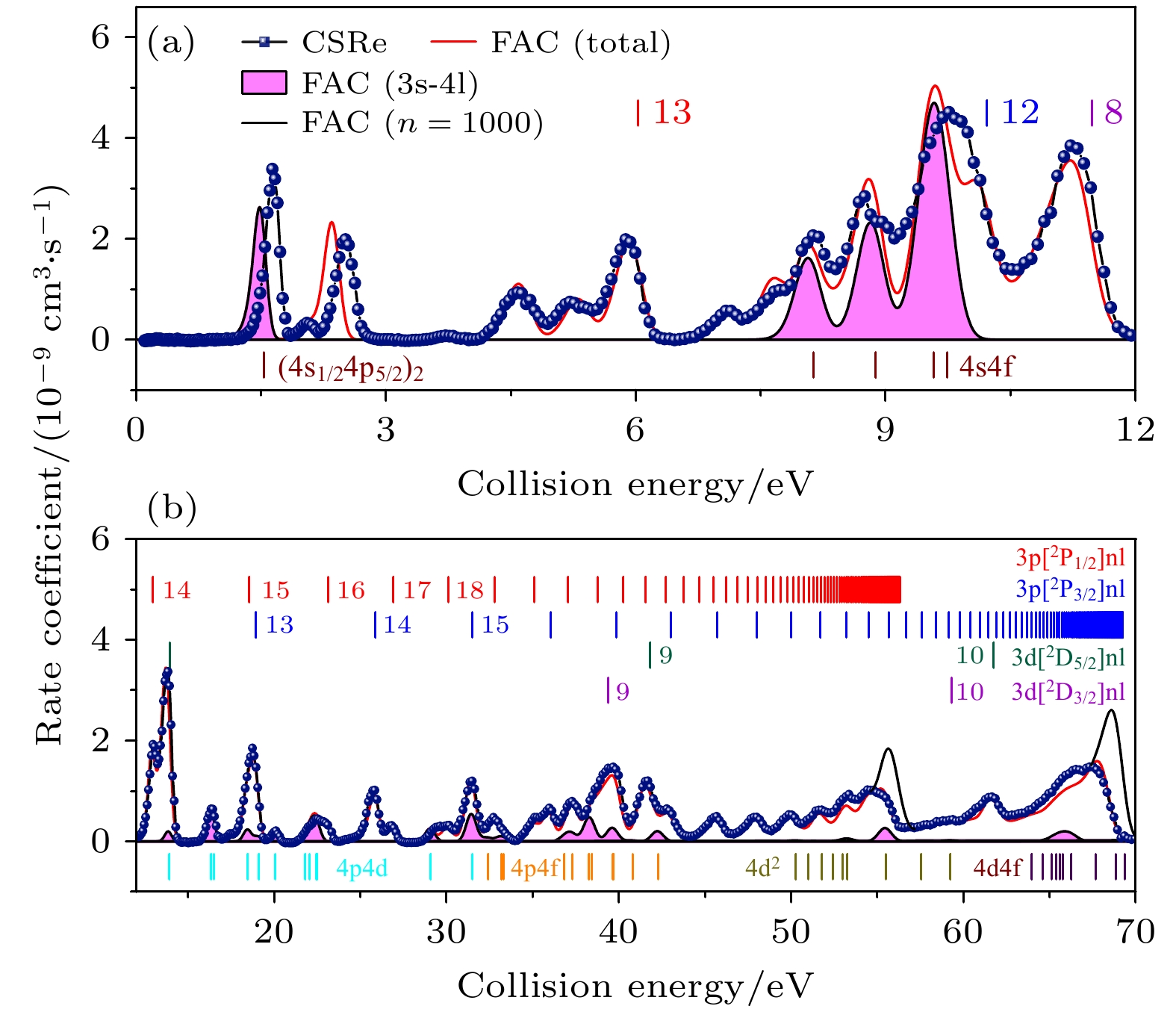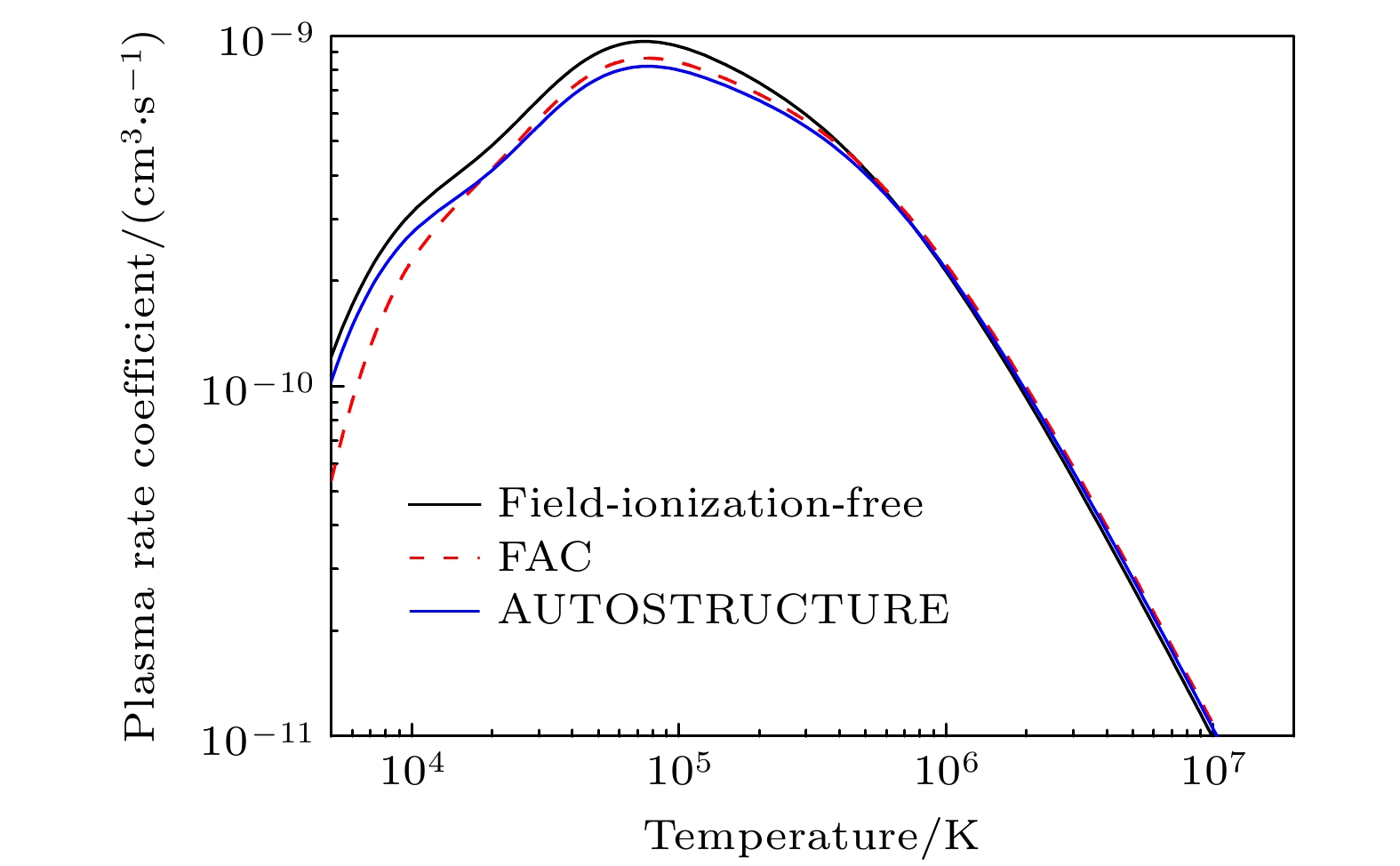-
The experimental study of precision spectroscopy of dielectronic recombination (DR) of highly charged ions is not only important for astronomical plasma and fusion plasma, but also can be used as a new precision spectroscopy to test the strong-field quantum electrodynamic effect, measure isotope shift, and extract the radius of atomic nuclei. An specially designed electron beam energy detuning system for electron-ion recombination precision spectroscopy experiments has been installed on the heavy ion storage ring CSRe in Lanzhou, China, where the electron-ion collision energy in the center-of-mass system can be detuned to 1 keV, and an independently-developed plastic scintillator detector and multiwire proportional chamber detector have been installed downstream of the electron cooler of the CSRe for detecting recombined ions. The multiwire proportional chamber detector has the ability to non-destructively monitor the profile of the ion beam in real-time while acquiring the recombined ion counts, providing guidance for optimizing the ion beam. On this basis, the first test experiment on dielectronic recombination of Kr25+ ions is carried out at the CSRe, and the dielectronic recombination rate coefficients in a range of 0–70 eV in the frame of center-of-mass are measured. In order to fully understand the experimental results, we calculate the dielectronic recombination rate coefficient of the Kr25+ ion by using the flexible atomic code (FAC) and make a detailed comparison with the experimental result, showing that they are in good agreement with each other, and only the resonance energy values of the two resonance peaks at 1.695 eV and 2.573 eV are significantly different. In addition, the DR resonance energy values and intensities are obtained by fitting the experimental results in a range of 0–35 eV, and we find that the transition 3s→4l (∆n = 1) contributes significantly to the experimental spectral lines. Furthermore, we compare the plasma rate coefficients derived from the DR rate coefficients with those derived from the AUTOSTRUCTURE and FAC theories, which differ by 20 percent in a temperature range less than 106 K. The experimental results show that the DR experimental platform of the CSRe has very good stability and reproducibility, and can provide support for the future DR experiments of highly charged ion, i.e. for testing strong-field quantum electrodynamics effect and measuring the properties of atomic nuclei.
-
Keywords:
- dielectronic recombination /
- storage ring CSRe /
- electron cooler /
- multiwire proportional chamber detector
[1] Gillaspy J D 2001 J. Phys. B: At. Mol. Opt. Phys. 34 R93
 Google Scholar
Google Scholar
[2] Kozlov M, Safronova M, López-Urrutia J C, Schmidt P 2018 Rev. Mod. Phys. 90 045005
 Google Scholar
Google Scholar
[3] Lindroth E, Danared H, Glans P, Pešić Z, Tokman M, Vikor G, Schuch R 2001 Phys. Rev. Lett. 86 5027
 Google Scholar
Google Scholar
[4] Brandau C, Kozhuharov C, Müller A, et al. 2003 Phys. Rev. Lett. 91 073202
 Google Scholar
Google Scholar
[5] Schuch R, Lindroth E, Madzunkov S, Fogle M, Mohamed T, Indelicato P 2005 Phys. Rev. Lett. 95 183003
 Google Scholar
Google Scholar
[6] Brandau C, Kozhuharov C, Harman Z A, et al. 2008 Phys. Rev. Lett. 100 073201
 Google Scholar
Google Scholar
[7] 啜晓亚, 黄忠魁, 汶伟强, 等 2018 原子核物理评论 35 196
 Google Scholar
Google Scholar
Chuai X Y, Huang Z K, Wen W Q, et al. 2018 Nucl. Phys. Rev. 35 196
 Google Scholar
Google Scholar
[8] Kieslich S, Schippers S, Shi W, et al. 2004 Phys. Rev. A 70 042714
 Google Scholar
Google Scholar
[9] Budker G, Kiselev A, Konkov N, Naumov A, Niffontov V, Ostreiko G, Petrov V, Yudin L, Yasnov G 1965 V International Conference on High Energy Accelerators Proceedings Frascati, September 9–16, 1965 p455
[10] Poth H 1990 Phys. Rep. 196 135
 Google Scholar
Google Scholar
[11] Mitchell J, Ng C, Forand J, Levac D, Mitchell R, Sen A, Miko D, McGowan J W 1983 Phys. Rev. Lett. 50 335
 Google Scholar
Google Scholar
[12] Dittner P, Datz S, Miller P, et al. 1983 Phys. Rev. Lett. 51 31
 Google Scholar
Google Scholar
[13] Müller A 2008 Advances In Atomic, Molecular, and Optical Physics (Academic Press) pp293–417
[14] Schippers S 2015 Nucl. Instrum. Methods Phys. Res. , Sect. B 350 61
 Google Scholar
Google Scholar
[15] Huang Z K, Wen W Q, Xu X, et al. 2018 Astrophys. J. Suppl. Ser. 235 2
 Google Scholar
Google Scholar
[16] Khan N, Huang Z K, Wen W Q, Mahmood S, et al. 2018 Chin. Phys. C 42 064001
 Google Scholar
Google Scholar
[17] Wang S X, Xu X, Huang Z K, et al. 2018 Astrophys. J. 862 134
 Google Scholar
Google Scholar
[18] Wang S X, Huang Z K, Wen W Q, et al. 2019 Astron. Astrophys. 627 171
 Google Scholar
Google Scholar
[19] Huang Z K, Wang S X, Wen W Q, et al. 2020 X-Ray Spectrom. 49 155
 Google Scholar
Google Scholar
[20] Wen W Q, Huang Z K, Wang S X, et al. 2020 Astrophys. J. 905 36
 Google Scholar
Google Scholar
[21] Khan N, Huang Z K, Wen W Q, et al. 2022 J. Phys. B: At. Mol. Opt. Phys. 55 035001
 Google Scholar
Google Scholar
[22] Huang Z K, Wen W Q, Wang S X, et al. 2020 Phys. Rev. A 102 062823
 Google Scholar
Google Scholar
[23] Shevelko V P, Stöhlker T, Tawara H, Tolstikhina I Y, Weber G 2010 Nucl. Instrum. Methods Phys. Res., Sect. B 268 2611
 Google Scholar
Google Scholar
[24] Yan K, Zhou Y, Ma X, Tang M, Gao D, Zhao H, Huang Z, Wen W, Mao L 2023 Nucl. Instrum. Methods Phys. Res. , Sect. A 1046 167699
 Google Scholar
Google Scholar
[25] Skorobogatov D, Bryzgunov M, Kondaurov M, Putmakov A, Reva V, Repkov V 2019 Proceedings of the 12th Workshop on Beam Cooling and Related Topics Novosibirsk, Russia, September 24–27, 2019 pp86–88
[26] Menz E B, Hahn C, Pfäfflein P, Weber G, Stöhlker T 2020 J. Phys. Conf. Ser. 1412 232006
 Google Scholar
Google Scholar
[27] Westman S, Kerek A, Klamra W, Norlin L O, Novak D 2002 Nucl. Instrum. Methods Phys. Res., Sect. A 481 655
 Google Scholar
Google Scholar
[28] Miersch G, Habs D, Kenntner J, Schwalm D, Wolf A 1996 Nucl. Instrum. Methods Phys. Res., Sect. A 369 277
 Google Scholar
Google Scholar
[29] Klepper O, Kozhuharov C 2003 Nucl. Instrum. Methods Phys. Res., Sect. B 204 553
 Google Scholar
Google Scholar
[30] Ye Y L, Di Z Y, Li Z H, Wang Q J, Zheng T, Chen T, Jiang D X, Ge Y C, Pang D Y, Li X Q 2003 Nucl. Instrum. Methods Phys. Res., Sect. A 515 718
 Google Scholar
Google Scholar
[31] Kilgus G, Habs D, Schwalm D, Wolf A, Badnell N R, Muller A 1992 Phys. Rev. A 46 5730
 Google Scholar
Google Scholar
[32] Schippers S, Bartsch T, Brandau C, Müller A, Gwinner G, Wissler G, Beutelspacher M, Grieser M, Wolf A, Phaneuf R A 2000 Phys. Rev. A 62 022708
 Google Scholar
Google Scholar
[33] Danared H 1995 Phys. Scr. 59 121
 Google Scholar
Google Scholar
[34] Badnell N R 2011 Comput. Phys. Commun. 182 1528
 Google Scholar
Google Scholar
[35] Badnell N 2006 Astrophys. J. 651 L73
 Google Scholar
Google Scholar
[36] Gu M F 2008 Can. J. Phys. 86 675
 Google Scholar
Google Scholar
[37] Gu M F 2003 Astrophys. J. 590 1131
 Google Scholar
Google Scholar
[38] Schippers S, Müller A, Gwinner G, Linkemann J, Saghiri A, Wolf A 2001 Astrophys. J. 555 1027
 Google Scholar
Google Scholar
[39] Schippers S, Schnell M, Brandau C, Kieslich S, Müller A, Wolf A 2004 Astron. Astrophys. 421 1185
 Google Scholar
Google Scholar
-
图 1 $ {Z}^{q+} $离子的双电子复合过程示意 (a) 第一步共振过程, 离子在俘获一个自由电子的同时将一个内壳层电子激发, 从而形成自电离态$ {{[Z}^{(q-1)+}]}^{{\mathrm{*}}{\mathrm{*}}} $; (b) 第二步过程, 自电离态离子通过辐射光子从而退激发到稳定态
Figure 1. Schematic of DR of $ {Z}^{q+} $ ions: (a) The first resonance step, in which the ion captures a free electron and simultaneously excites an inner shell electron, resulting in the formation of the autoionized state $ {{[Z}^{(q-1)+}]}^{{\mathrm{*}}{\mathrm{*}}} $; (b) the second step, in which the ion is deexcited to the stable state by radiative decay.
图 6 (a) 复合离子探测器探测的复合离子计数-电子束调制能量谱; (b) 总的复合速率系数-质心系碰撞能量谱, 插图中的红色曲线为拟合结果, 拟合得到了电子束的横向温度与纵向温度; (c) 减去背景与RR的贡献后得到的绝对DR速率系数-碰撞能量谱
Figure 6. (a) Counts of recombined ions detected by the ion detector as a function of the electron beam detuning voltage; (b) total recombined rate coefficient at the center-of-mass collision energy; (c) the absolute DR rate coefficient by subtracting the contributions of the background and RR. In addition, the red curve in the inset of panel (b) is the fitting results.
图 7 蓝色点线和红色实线分别为CSRe测量的Kr25+离子双电子复合速率与FAC计算的理论结果, 阴影部分为$ \Delta n=1 $的部分. 竖线为基于里德伯公式估算的双电子复合共振位置
Figure 7. Experimental (dotted blue line) and theoretical (red solid line) dielectronic recombination rate coefficients of the Na-like Kr25+ ions. The shaded part is the part with $ \Delta n=1 $ core excitation.
图 8 Kr25+离子的实验(黑色实线)与FAC(红色虚线)及AUTOSTRUCTURE[22](蓝色实线)理论导出的等离子体速率系数谱对比
Figure 8. Comparision of plasma rate coefficients of sodium-like Kr25+ ions between experimental results (black solid line) and calculations by FAC (red dashed line) and AUTOSTRUCTURE (blue line) code.
表 1 CSRe上Kr25+离子双电子复合实验参数
Table 1. Parameters of the DR experiment of Kr25+ at CSRe.
实验参数 实验装置(CSRe) 储存环周长/m 128.8 相互作用长度/m 4.0 离子束能量/(MeV·u–1) 80 离子束流强/μA 300—450 电子束流强/mA 287.5 电子束半径/cm 2.60 横向电子温度/meV 75.14 纵向电子温度/meV 1.26 冷却段磁场强度/G 390 枪区磁场强度/G 1250 表 2 实验测量拟合结果与理论计算结果对比
Table 2. Comparison of experimental measurement fitting results with theoretical calculations.
双激发态组态 共振能量/eV 共振强度/(10–19 eV·cm2) FAC 实验 FAC 实验 4s[2S1/2]4d5/2 (J = 2) 1.530 1.695±0.001 75.2 93.8±0.6 3d[2D3/2]8s (J = 1) 2.090 2.119±0.009 7.1 8.4±0.6 3d[2D3/2]8s (J = 2) 2.405 2.573±0.001 62.2 56.1±0.6 3p[2P1/2]13s 3.869 3.804±0.049 1.5 1.9±0.6 3d[2D5/2]8s (J = 3) 4.530 7.3 3p[2P1/2]13p1/2 4.565a 4.4 Blend 4.543a 4.561±0.012 11.7 17.4±1.2 3d[2D3/2]8p1/2 (J = 2) 4.660 6.4 3d[2D5/2]8s (J = 2) 4.690 11.0 3d[2D3/2]8p1/2 (J = 1) 4.754 3.9 Blend 4.693a 4.789±0.013 21.2 15.8±1.2 3d[2D3/2]8p3/2 5.338 5.216±0.021 14.8 13.8±1.7 3p[2P1/2]13d 5.384a 5.448±0.032 7.2 11.5±1.4 3p[2P1/2]13f 5.838a 5.747±0.029 12.4 13.9±1.5 3p[2P1/2]13l (l ≥ g) 6.003a 6.000±0.006 40.4 44.7±1.9 3d[2D5/2]8p1/2 (J = 2, 3) 7.129a 7.154±0.022 14.6 12.5±1.3 3p[2P3/2]12s (J = 1, 2) 7.465a 7.494±0.095 2.0 6.8±2.3 3d[2D5/2]8p3/2 (J = 2, 3, 4) 7.705a 7.767±0.034 26.8 18.6±2.2 4s[2S1/2]4f5/2 (J = 2) 8.129 8.161±0.028 37.9 39.2±5.2 3d[2D5/2]8p3/2 (J = 1) 8.063 2.3 3p[2P3/2]12p1/2 8.245 2.2 3p[2P3/2]12p3/2 (J = 1, 2, 3) 8.404a 3.8 3d[2D3/2]8d3/2 8.596 12.7 Blend 8.466a 8.391±0.045 21.0 20.1±5.2 4s[2S1/2]4f5/2(J = 3) 8.880 8.790±0.010 53.9 58.2±1.3 3d[2D3/2]8d5/2 8.813a 21.1 3p[2P3/2]12d 9.404a 8.9 Blend 8.988a 9.143±0.014 30.0 41.2±1.3 4s[2S1/2]4f5/2 (J = 4) 9.577 9.546±0.018 65.7 60.6±4.0 4s[2S1/2]4f5/2 (J = 3) 9.737 9.842±0.023 55.8 75.1±3.2 3p[2P3/2]12l (l ≥ f ) 10.139a 10.138±0.020 77.5 67.0±3.8 3d[2D3/2]8f 10.721a 10.694±0.041 39.8 51.9±2.0 3d[2D5/2]8d 11.227a 11.224±0.023 33.1 58.3±2.8 3d[2D3/2]8l (l ≥ g ) 11.313a 11.504±0.009 70.7 60.3±4.5 3p[2P1/2]14d 12.443a 12.732±0.044 3.5 10.1±1.7 3p[2P1/2]14l (l ≥ f ) 12.907a 13.101±0.013 19.4 41.0±1.4 3d[2D5/2]8f 13.276a 13.616±0.018 25.4 39.2±1.8 3d[2D5/2]8l (l ≥ g) 13.770a 13.964±0.006 83.4 67.5±2.2 4p[2P1/2]4d5/2 (J = 3) 16.337 12.3 4p[2P1/2]4d5/2 (J = 2) 16.500 4.0 Blend 16.377a 16.482±0.013 16.3 14.1±1.0 3p[2P3/2]13p 17.491a 17.36±0.14 2.4 2.0±1.0 3p[2P1/2]15p 17.601a 17.74±0.12 0.8 3.0±0.8 Blend 17.517a 17.579±0.036 3.2 3.3±0.3 3p[2P1/2]15d 18.131a 1.4 3p[2P3/2]13d 18.313a 3.6 Blend 18.262a 18.226±0.057 5.1 7.2±1.4 4p[2P1/2]4d5/2 (J = 1) 18.466 5.2 3p[2P1/2]15l (l ≥ f) 18.533a 8.8 Blend 18.508a 18.609±0.031 14.0 21.6±1.0 3p[2P3/2]13l (l ≥ f) 18.930a 18.976±0.008 25.5 32.2±1.6 4p[2P3/2]4d5/2 (J = 2) 20.038 20.162±0.022 5.1 4.2±0.3 4p[2P3/2]4d5/2 (J = 0) 21.802 1.7 4p[2P3/2]4d5/2 (J = 1) 22.054 4.2 Blend 21.984a 22.086±0.025 5.9 5.1±0.3 4p[2P3/2]4d5/2 (J = 3) 22.444 4.3 4p[2P3/2]4d5/2 (J = 2) 22.502 5.4 Blend 22.476a 22.614±0.020 9.7 8.7±0.3 3p[2P1/2]16l 23.005a 23.164±0.018 9.5 7.3±0.3 3p[2P3/2]14p 24.715a 1.4 3p[2P3/2]14d 25.371a 2.2 Blend 25.111a 25.480±0.052 3.6 7.1±1.0 3p[2P3/2]14l (l ≥ f) 25.865a 25.941±0.013 20.7 21.2±1.0 3p[2P1/2]17l 26.821a 26.917±0.022 7.2 7.0±0.4 3p[2P1/2]18l 30.020a 30.277±0.024 6.1 6.8±0.3 3p[2P3/2]15l 31.348a 31.695±0.011 16.4 22.6±0.9 4p[2P1/2]4f5/2 (J = 3) 32.424 1.6 3p[2P1/2]19l 32.739a 7.5 Blend 32.683a 32.804±0.028 9.2 9.5±0.5 a Weighted energy: $ {E}_{{\mathrm{d}}}= {\displaystyle\sum {E}_{{\mathrm{d}}}{S}_{{\mathrm{d}}}}\Big/{\displaystyle\sum {S}_{{\mathrm{d}}}} $ 表 3 实验与FAC理论计算得到的复合速率系数导出的等离子体速率系数拟合参数, ci与Ei的单位分别为cm3·s–1与eV, 括号内的数字为10的幂
Table 3. Fitted coefficients for the plasma rate coefficients of DR experiment and FAC, the ci are in units of cm3·s–1, and the Ei are in eV. The numbers in the square brackets are power of 10.
i 实验 FAC ci Ei ci Ei 1 1.01[–1] 37.1 4.65[–2] 24.7 2 2.28[–1] 63.9 2.07[–1] 53.4 3 1.95[–3] 1.74 7.35[–2] 92.9 4 3.30[–2] 121 1.05[–2] 6.15 5 3.99[–2] 15.5 8.90[–4] 1.42 6 4.34[–2] 9.07 1.57[–3] 2.36 7 3.88[–3] 4.17 5.37[–2] 5.37 -
[1] Gillaspy J D 2001 J. Phys. B: At. Mol. Opt. Phys. 34 R93
 Google Scholar
Google Scholar
[2] Kozlov M, Safronova M, López-Urrutia J C, Schmidt P 2018 Rev. Mod. Phys. 90 045005
 Google Scholar
Google Scholar
[3] Lindroth E, Danared H, Glans P, Pešić Z, Tokman M, Vikor G, Schuch R 2001 Phys. Rev. Lett. 86 5027
 Google Scholar
Google Scholar
[4] Brandau C, Kozhuharov C, Müller A, et al. 2003 Phys. Rev. Lett. 91 073202
 Google Scholar
Google Scholar
[5] Schuch R, Lindroth E, Madzunkov S, Fogle M, Mohamed T, Indelicato P 2005 Phys. Rev. Lett. 95 183003
 Google Scholar
Google Scholar
[6] Brandau C, Kozhuharov C, Harman Z A, et al. 2008 Phys. Rev. Lett. 100 073201
 Google Scholar
Google Scholar
[7] 啜晓亚, 黄忠魁, 汶伟强, 等 2018 原子核物理评论 35 196
 Google Scholar
Google Scholar
Chuai X Y, Huang Z K, Wen W Q, et al. 2018 Nucl. Phys. Rev. 35 196
 Google Scholar
Google Scholar
[8] Kieslich S, Schippers S, Shi W, et al. 2004 Phys. Rev. A 70 042714
 Google Scholar
Google Scholar
[9] Budker G, Kiselev A, Konkov N, Naumov A, Niffontov V, Ostreiko G, Petrov V, Yudin L, Yasnov G 1965 V International Conference on High Energy Accelerators Proceedings Frascati, September 9–16, 1965 p455
[10] Poth H 1990 Phys. Rep. 196 135
 Google Scholar
Google Scholar
[11] Mitchell J, Ng C, Forand J, Levac D, Mitchell R, Sen A, Miko D, McGowan J W 1983 Phys. Rev. Lett. 50 335
 Google Scholar
Google Scholar
[12] Dittner P, Datz S, Miller P, et al. 1983 Phys. Rev. Lett. 51 31
 Google Scholar
Google Scholar
[13] Müller A 2008 Advances In Atomic, Molecular, and Optical Physics (Academic Press) pp293–417
[14] Schippers S 2015 Nucl. Instrum. Methods Phys. Res. , Sect. B 350 61
 Google Scholar
Google Scholar
[15] Huang Z K, Wen W Q, Xu X, et al. 2018 Astrophys. J. Suppl. Ser. 235 2
 Google Scholar
Google Scholar
[16] Khan N, Huang Z K, Wen W Q, Mahmood S, et al. 2018 Chin. Phys. C 42 064001
 Google Scholar
Google Scholar
[17] Wang S X, Xu X, Huang Z K, et al. 2018 Astrophys. J. 862 134
 Google Scholar
Google Scholar
[18] Wang S X, Huang Z K, Wen W Q, et al. 2019 Astron. Astrophys. 627 171
 Google Scholar
Google Scholar
[19] Huang Z K, Wang S X, Wen W Q, et al. 2020 X-Ray Spectrom. 49 155
 Google Scholar
Google Scholar
[20] Wen W Q, Huang Z K, Wang S X, et al. 2020 Astrophys. J. 905 36
 Google Scholar
Google Scholar
[21] Khan N, Huang Z K, Wen W Q, et al. 2022 J. Phys. B: At. Mol. Opt. Phys. 55 035001
 Google Scholar
Google Scholar
[22] Huang Z K, Wen W Q, Wang S X, et al. 2020 Phys. Rev. A 102 062823
 Google Scholar
Google Scholar
[23] Shevelko V P, Stöhlker T, Tawara H, Tolstikhina I Y, Weber G 2010 Nucl. Instrum. Methods Phys. Res., Sect. B 268 2611
 Google Scholar
Google Scholar
[24] Yan K, Zhou Y, Ma X, Tang M, Gao D, Zhao H, Huang Z, Wen W, Mao L 2023 Nucl. Instrum. Methods Phys. Res. , Sect. A 1046 167699
 Google Scholar
Google Scholar
[25] Skorobogatov D, Bryzgunov M, Kondaurov M, Putmakov A, Reva V, Repkov V 2019 Proceedings of the 12th Workshop on Beam Cooling and Related Topics Novosibirsk, Russia, September 24–27, 2019 pp86–88
[26] Menz E B, Hahn C, Pfäfflein P, Weber G, Stöhlker T 2020 J. Phys. Conf. Ser. 1412 232006
 Google Scholar
Google Scholar
[27] Westman S, Kerek A, Klamra W, Norlin L O, Novak D 2002 Nucl. Instrum. Methods Phys. Res., Sect. A 481 655
 Google Scholar
Google Scholar
[28] Miersch G, Habs D, Kenntner J, Schwalm D, Wolf A 1996 Nucl. Instrum. Methods Phys. Res., Sect. A 369 277
 Google Scholar
Google Scholar
[29] Klepper O, Kozhuharov C 2003 Nucl. Instrum. Methods Phys. Res., Sect. B 204 553
 Google Scholar
Google Scholar
[30] Ye Y L, Di Z Y, Li Z H, Wang Q J, Zheng T, Chen T, Jiang D X, Ge Y C, Pang D Y, Li X Q 2003 Nucl. Instrum. Methods Phys. Res., Sect. A 515 718
 Google Scholar
Google Scholar
[31] Kilgus G, Habs D, Schwalm D, Wolf A, Badnell N R, Muller A 1992 Phys. Rev. A 46 5730
 Google Scholar
Google Scholar
[32] Schippers S, Bartsch T, Brandau C, Müller A, Gwinner G, Wissler G, Beutelspacher M, Grieser M, Wolf A, Phaneuf R A 2000 Phys. Rev. A 62 022708
 Google Scholar
Google Scholar
[33] Danared H 1995 Phys. Scr. 59 121
 Google Scholar
Google Scholar
[34] Badnell N R 2011 Comput. Phys. Commun. 182 1528
 Google Scholar
Google Scholar
[35] Badnell N 2006 Astrophys. J. 651 L73
 Google Scholar
Google Scholar
[36] Gu M F 2008 Can. J. Phys. 86 675
 Google Scholar
Google Scholar
[37] Gu M F 2003 Astrophys. J. 590 1131
 Google Scholar
Google Scholar
[38] Schippers S, Müller A, Gwinner G, Linkemann J, Saghiri A, Wolf A 2001 Astrophys. J. 555 1027
 Google Scholar
Google Scholar
[39] Schippers S, Schnell M, Brandau C, Kieslich S, Müller A, Wolf A 2004 Astron. Astrophys. 421 1185
 Google Scholar
Google Scholar
Catalog
Metrics
- Abstract views: 6548
- PDF Downloads: 270
- Cited By: 0














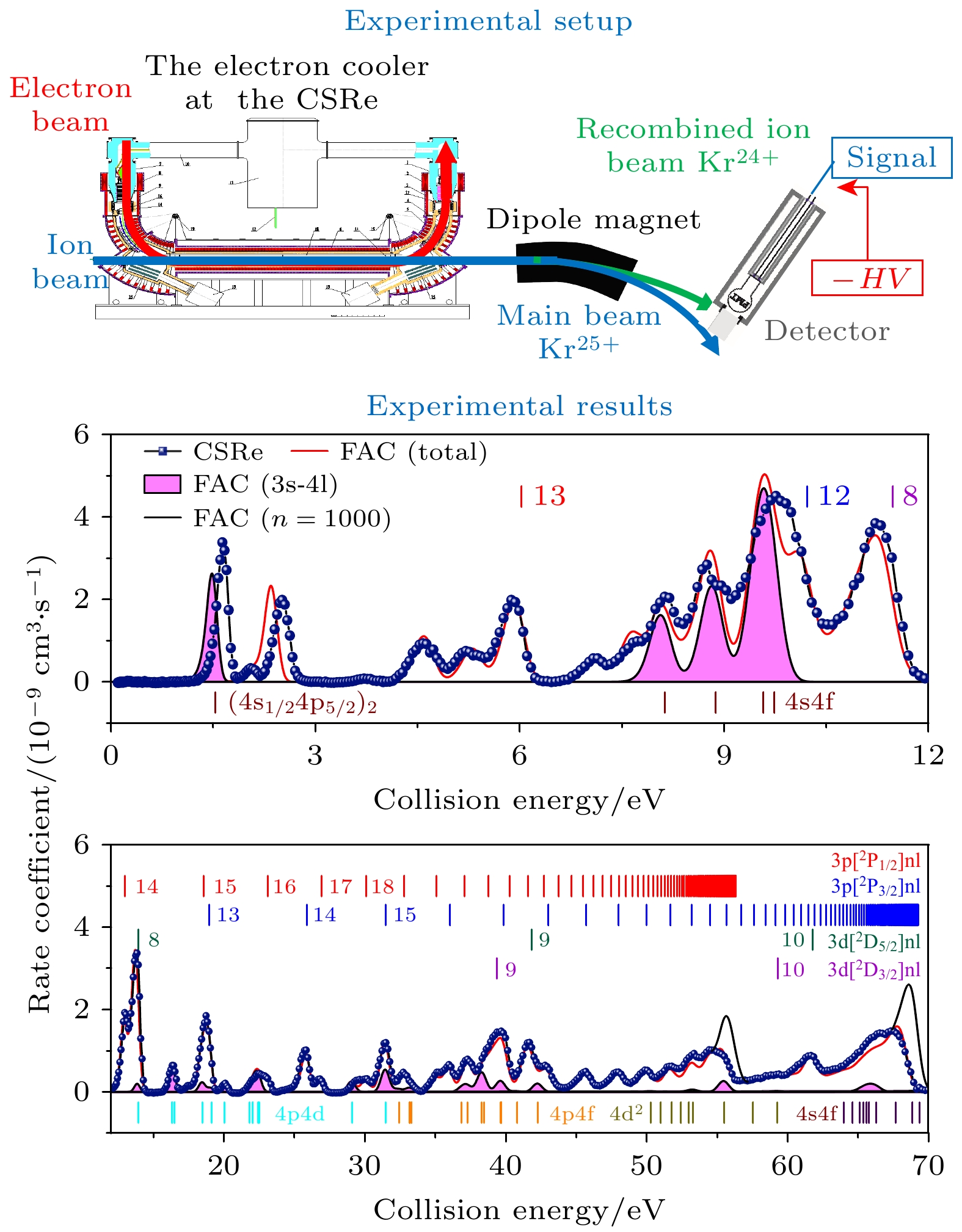
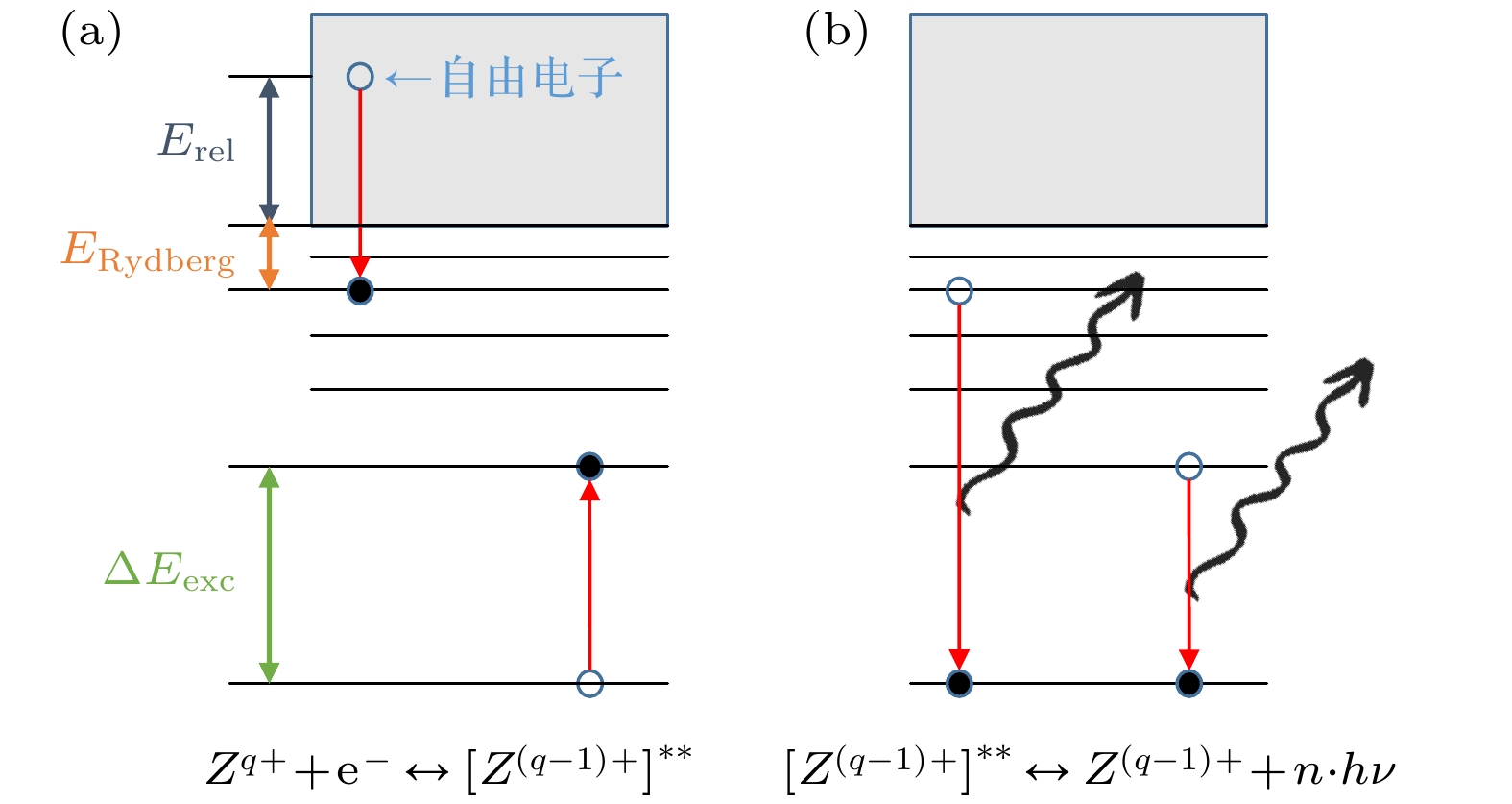
 DownLoad:
DownLoad:
